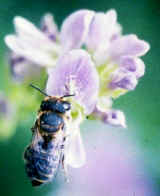![]()
![]()
What is pollination?Some definitions.
NEW!
A bee identification exercise to
try with master gardeners, kids and other groups.
|
 |
| Pollination
Read about Iris flowers and pollination
|
Pollination:
The transfer of pollen from the anthers of a flower to the stigma of the same
flower or of another flower. Pollination is a prerequisite for
fertilization: the fusion of nuclei from the pollen
grain with nuclei in the ovule. Fertilization allows
the flower to develop seeds. Most plants need help moving pollen from one flower to the pistil of another. Wind moves the pollen for some plants such as grasses like corn. Animal pollinators move pollen for many other flowering plants. Pollinator: An animal that moves pollen from the anthers to the stigmas of flowers, thus effecting pollination. Animals that are known to be good pollinators of flowers include bees, butterflies, hummingbirds, moths, some flies, some wasps, and nectar feeding bats. What are the benefits? Plants benefit from pollinators because the movement of pollen allows them to reproduce by setting seeds. However, pollinators don't know or care that the plant benefits. They pollinate to get nectar and/or pollen from flowers to meet their energy requirements and to produce offspring. In the economy of nature, the pollinators provide an important service to flowering plants, while the plants pay with food for the pollinators and their offspring. |
Links to information about parts of a flower:
The Great Plant Escape Get involved in a world-wide pollination
project: |
![]()
Top of Page Pollinator Paradise Pollination Ecology at UI The Solitary Bee Web Trapnesting Wasps and Bees
![]()